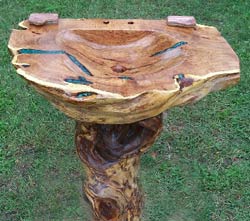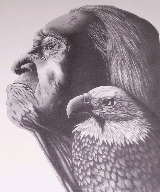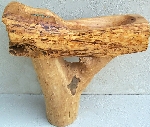
Spirit Ayastigi carves sinks from solid blocks of figured wood. I’m not talking about turned bowls that double as makeshift sinks; I’m talking about fully functional, hand carved, freeform sinks, pre-drilled to accept standard plumbing fixtures, finished, and ready to use. Not surprisingly, to those of us who know and love wood, they are also quite beautiful. Sinks, though, are only a small part of the eclectic output from the Texas studio of this soft-spoken and talented Native American artist.
In case you were wondering, “Ayastigi” (ah-YAH-sti-gi) is Cherokee for “warrior,” a name he adopted as an adult. “Spirit” was what his grandmother named him at birth, but for many years, he went by the name Paul Lewis. He started delving into his native roots at the age of 25, and the name change followed a few years later.
“I was born in 1964 in Missouri,” Spirit recounted, “and raised on a farm by my adopted parents. My adopted father was a hobby woodworker, and I have been woodworking since the age of ten.” As a child, he says he spent a lot of time wandering in the woods gathering pieces for knives, slingshots, and the other toys of youth, as well as doing more traditional woodworking. “I got out of woodworking in high school, and afterward, did a variety of mostly construction jobs, learning landscaping, masonry, carpentry, carving, flint napping, (making stone arrowheads and knife blades) and crafting Native American flutes.”
“I get to where I do something for a certain period of time, and I am ready to move on to something else. My goal is to get proficient enough to make a living with any of seven different mediums.”

Seven is a native spiritual number reflecting the “seven directions”: north, south, east, west, above, below and within. So far, he has checked off five: log carvings, such as the sinks, charcoal and oil portraits, flint napping, crafting (and playing) Native American flutes, and knife making. He plans to add life-size sculpture in the round, and cap off the seven by becoming either an author or a musician. “I want to write self-help books along the lines of non-religious spirituality,” he explained when I questioned him about his desire to be an author. “I think more love is needed in this world, and we are not taught that as children.” Though he does not list teaching among his seven crafts, he does it, offering instruction in both charcoal portraiture and flint napping.
Most of his current skills he learned from talking to people, reading books and working at a variety of jobs. In 1992, he started making wood handled metal and stone knives, crafting both the blades and handles. From there, he moved on to building entertainment centers, but found he preferred a more free-form construction, and more natural materials, to working with flat boards. For example, his Native American flutes are made from found dead tree limbs. “Mother Nature makes the wood,” Spirit said. “We just find the beauty in it and bring it out.”

In about 1996, he started doing charcoal portraits, something he says he adores and still does, then flint napping in 2000 and, most recently, log sinks. “Surprisingly, there are very few problems with making sinks,” Spirit told me. “About three or four years ago, I got the idea to make wood sinks. Wood mining troughs, boats, wood water towers, and of course wine casks and water barrels are made of wood, so why not sinks?” After researching it on the Internet, he decided to dive in. He’s not the only one making wood sinks, but his may well be the most unusual.
He starts with air-dried wood, sometimes “finished” in a kiln, after it is carved, to eliminate any bugs. The mesquite for the sink on his web site’s home page is part of a huge burl he found while looking for flute wood. He cut it in half, then carved the bowl, roughing it out with chain saws before switching to hand chisels. About 65 percent of the carving is done with chisels, forming the depth, shape, and final look. Finally, it is sanded with a hand grinder, cracks are filled with epoxy, then the whole thing is finished with Waterlox. All his sinks are drilled to take standard plumbing fixtures, and the bases are designed to hide most of the plumbing within them. Soon to come are carved bathtubs, entertainment centers and kitchen islands, each carved from one block of wood.

This Spirit extends his spirit to the community as well, and gives locally whenever possible. His web site clearly promises “Seven percent of the sale price of our wood sinks will benefit people in need. Our intent is to help through giving directly to individuals in need or nonprofit groups that provide 100% of the money for basic medical care, shelter, food or social services.” It’s a fine example of one whose actions validate his beliefs. “Love yourself first,” he says, “then treat others the way you treat yourself.”





